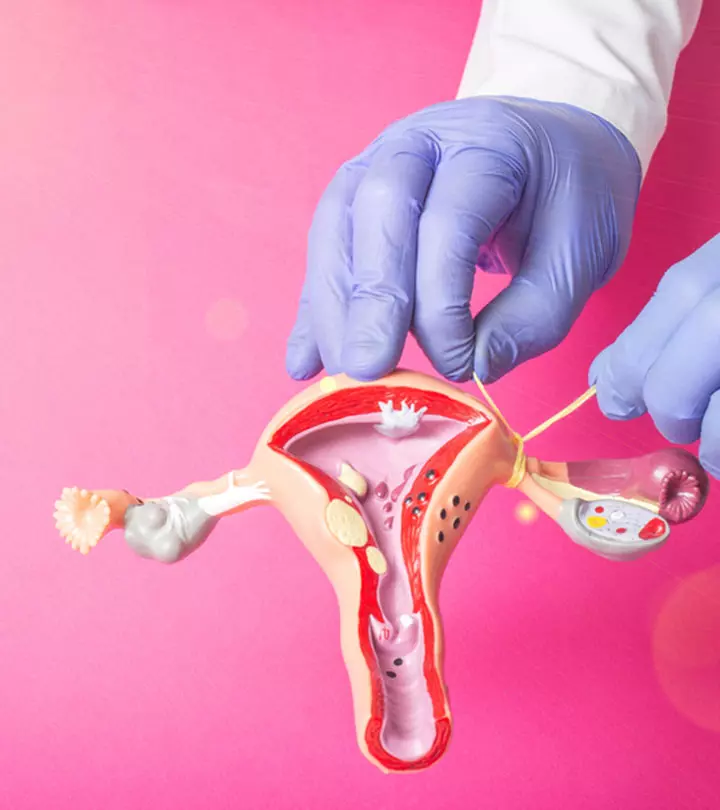
Image: Shutterstock
Bleeding after C-section is normal. Also called lochia, this bleeding consists of mucus, tissue, and blood that the uterus sheds as it replaces its lining following the delivery (1) (2). Bleeding after cesarean delivery may be heavy and bright red during the first week after birth and become lighter and brownish over time. It usually continues for 24 to 42 days after birth; however, some women may bleed for a little longer (1). Knowing what to expect with bleeding after a cesarean reduces anxiety and helps new mothers adjust to motherhood. Read this post to learn more about the causes of bleeding after a C-section and ways to manage it.

Key Pointers
- Bleeding after a C-section is a common occurrence.
- The bleeding is caused by the removal of residual tissue from the uterus.
- The amount of blood loss after a C-section can vary and is influenced by factors such as breastfeeding and physical activity.
- Maternity pads can be used to manage the bleeding.
- If sudden heavy bleeding or dizziness occurs, it is important to consult a doctor immediately.
How Heavy Is The Bleeding After A C-Section?

The amount of blood loss after a C-section depends on several factors (1) (3).
- Bleeding is heavy and bright red after breastfeeding because the oxytociniA hormone secreted by the pituitary gland to stimulate contractions during childbirth and lactation released during the process compresses the uterus, thus producing more blood.
- Any physical activity may cause bleeding during the first two weeks after delivery.
- Heavier bleeding may also be experienced after you wake up in the morning because the blood may accumulate in the vagina while you are sleeping at night.
 Quick fact
Quick factThe following bleeding pattern is commonly seen in women after a C-section. However, it may vary from one person to another (1).
| Days/weeks | Color of the blood | Amount of blood loss |
|---|---|---|
| Day 1 | Fresh red to brownish-red |
|
| Days 2 to 6 | Dark brown or pinkish-red |
|
| Days 7 to 10 | Darker brown or pinkish-red; turns lighter |
|
| Days 11 to 14 | Darker brown or pinkish-red; turns lighter |
|
| Week 3 to 4 | Pale, creamy white blood |
|
| Week 5 to 6 | Brown, pinkish-red, or creamy yellow |
|
Source: nct
What Causes Bleeding After C-Section?

During delivery, the placentaiA temporary organ that develops during pregnancy and provides the fetus with oxygen and nutrients detaches from the uterus lining (endometrium), leaving behind an open wound of around 8.5in in diameter (placental site). This wound takes time to heal. As the uterus heals, the residual tissue slowly comes out in the form of uterine bleeding and vaginal discharge (4). In the case of vaginal delivery, up to a half-quart (500ml) of blood is lost, whereas in the case of cesarean delivery, up to a quart (1000ml) of blood is lost (5).
Bleeding after birth (lochia) can be divided into three stages (4).
1. Lochia rubra
- This stage lasts for the first four days after delivery.
- You may experience regular abdominal cramps as the uterus begins to contract to its original size.
- The lochia is bright red with clots caused due to the pooling of blood.
2. Lochia serosa
- This stage lasts for around ten days.
- You may notice the blood changing from bright red to pink or brown. The color change occurs as the number of white blood cells in the blood increases.
- The placental site continues to heal during this stage.
- If you are not breastfeeding, you may notice the discharge of cervical fluid. However, if you are breastfeeding, the cervical fluid may not be seen yet.
3. Lochia alba
- This is the final and the longest stage.
- The lochia turns yellowish or whitish. It mainly consists of white blood cells, cervical mucusiA gel-like discharge produced by the cervix that indicates the most fertile time of your menstrual cycle , and epithelial tissueiA major tissue that covers the internal and external surface of the body, body cavities, and hollow organs .
- The placental site continues to heal rapidly.
Besides physical discomfort, bleeding after a cesarean can bring emotional concerns. Seek support from family, fellow mothers, or your gynecologist to manage stress and aid recovery.
How To Manage Bleeding After C-Section?
Postpartum bleeding is normal and taking a few smart precautions can help manage the phase easily and without any adverse reactions. Here are important points to help you manage post C-section bleeding effectively while reducing the risk of infections (3) (6):
- Bleeding after a C-section can be managed by using maternity pads. These pads offer more comfort than regular sanitary pads and allow you to check the amount of blood loss.
Bethany Fontaine, a mother of two and a vlogger, shares a tip about handling postpartum bleeding. She says, “I found a really good tip for recovery.. buying the 10-pack of Walmart underwear—this big, high-waisted cotton underwear that are super like major granny panties, but they work so well. And it’s great because they do come above your incision, which is what you really want to look for. You don’t want underwear to cut right into that because it is painful and it’s very sensitive (i).”
- Avoid the use of tampons or menstrual cups for the first six weeks after childbirth.
- Change the sanitary pads at regular intervals.

- Wash your hands before and after changing the sanitary pads.
- Rest whenever possible to reduce strain and bleeding.
- Stay hydrated and maintain good nutrition to support overall healing.
- Take pain medication as prescribed by your doctor, which can help manage discomfort associated with both the incision and uterine contractions.
- Be attentive to any sudden increase in bleeding, passage of large clots (golf ball-sized or larger), or return to bright red bleeding after it has lightened.
- Breastfeeding may help manage post-C-section bleeding by stimulating the release of oxytocin, a hormone that promotes uterine contractions, which also helps reduce postpartum bleeding (7) (8). As per a study, initiating bilateral breast sucking within the first two hours after delivery decreased the amount of lochia (9).
When To Call The Doctor?
You should contact your doctor if you notice the following symptoms (3) (10).
- Sudden heavy bleeding (soaking of one pad in one to two hours)
- Large blood clot (bigger than the size of a golf ball)
- Change in the color of the blood (changes to bright red)
- Dizziness and weakness
- Chills with fever lasting more than two days

- Foul-smelling vaginal discharge or blood
- Severe pain and discomfort in the lower abdomen
The presence of large blood clots, especially those bigger than the size of a golf ball, also warrants immediate medical attention. Large blood clots after birth could indicate that the uterus is not contracting properly.
These symptoms may indicate postpartum hemorrhage (PPH), a life-threatening condition causing excessive bleeding after childbirth. Doctors diagnose PPH through blood tests, pelvic examinations, ultrasounds, blood loss measurements, and physical assessments. Treatment depends on the bleeding cause but typically includes medications to help uterine contractions to reduce blood loss (11).
Taking supplements may help reduce the risk of excessive blood loss after a C-section. During pregnancy, the body increases red blood cell production to compensate for blood loss during childbirth, which raises the need for iron. Following a healthcare provider’s guidance on iron supplementation can support recovery and replenish iron levels (5).
 Quick fact
Quick factFrequently Asked Questions
1. What if I bleed longer than six weeks after a C-section?
It is normal for a woman to bleed for four to six weeks after a C-section. How long you bleed after a c- section depends on various factors as some women may bleed for a little longer. However, the bleeding should stop by 12 weeks after birth (3). If the bleeding continues beyond that or becomes heavier, it is advisable to consult a doctor as it might indicate signs of infections.
2. What are the symptoms of postpartum hemorrhage after a cesarean delivery?
Postpartum hemorrhage can present various symptoms, such as excessive bleeding, a significant decrease in blood pressure, an elevation in heart rate, a reduction in red blood cell count, and tissue pain and swelling in the vaginal perinealiThe space between the anus and vulva forms the floor of the pelvic cavity areas (12). Postpartum hemorrhage may result from several factors, such as hematoma, blood clotting disorders, and placental problems. Also, contracting an infection can increase the likelihood of experiencing postpartum hemorrhage.
3. Is it normal to have on-and-off bleeding after a C-section?
Bleeding after the C-section is heavy initially, and it lessens over time. There may be uterine cramping and a slight increase in blood flow each time you breastfeed due to the hormones-induced uterine contractions. The bleeding may also be heavier when you wake up in the morning as the blood gets pooled in the vagina because you are lying down all night. Barring these minor changes, any bleeding that suddenly starts or increases in volume needs prompt medical attention (3).
4. How much blood loss is too much during a C-section?
Losing more than 1000ml of blood after a C-section may be worrisome and needs immediate medical care (12).
5. Can breastfeeding affect bleeding after a C-section?
Breastfeeding might trigger hormonal changes, which can stimulate uterine contractions and lead to an increase in blood flow following a C-section. While these effects are a typical part of postpartum recovery, seek timely medical advice to facilitate proper healing and address any specific concerns (3).
Bleeding after a cesarean birth is a normal process in which the uterus expels the extra tissue and blood and returns to its original size. Good nutrition, proper hydration, and adequate rest can help you recover faster during the postpartum period. However, you should regularly monitor the amount and duration of your blood flow.
Infographic: What Are The Stages Of Bleeding After A C-Section?
After a C-section, many women experience vaginal bleeding (lochia) in various stages that may linger for a few days. Understanding these bleeding stages might help women know when to seek medical attention and ensure a healthy postpartum recovery. The infographic below explains the different types of post-cesarean bleeding stages and their features.
Some thing wrong with infographic shortcode. please verify shortcode syntaxLearn about normal bleeding after birth and labor, and how much is too much in this video. Understand the signs of excessive bleeding and when to seek medical help.
Personal Experience: Source
MomJunction articles include first-hand experiences to provide you with better insights through real-life narratives. Here are the sources of personal accounts referenced in this article.
i. WHAT TO EXPECT Before, During + After A C-SECTION | EVERYTHING I Wish I Knew! | Bethany Fontaine.
https://youtu.be/V40Qs–ugkQ?feature=shared
References
- Bleeding after birth: 10 things you need to know.
https://www.nct.org.uk/information/labour-birth/recovery-birth/bleeding-after-birth-and-postpartum-haemorrhage-pph - Recovery after cesarean: first 6 weeks.
https://raisingchildren.net.au/pregnancy/labour-birth/recovery-after-birth/after-caesarean - Bleeding after a c-section: what to expect.
https://www.tommys.org/pregnancy-information/giving-birth/caesarean-section/bleeding-after-c-section-what-expect - Everything You Need to Know about Postpartum Bleeding aka Lochia.
https://naturalwomanhood.org/three-stages-of-lochia-is-postpartum-bleeding-normal/?gclid=Cj0KCQiAnuGNBhCPARIsACbnLzrT13aYPwmVqHYfOkIuilOk2Q9dJoYsV_oAJeYMEsM-AgZzqWldgF4aAopYEALw_wcB - Postpartum hemorrhage: How much bleeding after delivery is normal?
https://utswmed.org/medblog/postpartum-hemorrhage/ - Postpartum Hemorrhage.
https://my.clevelandclinic.org/health/diseases/22228-postpartum-hemorrhage - Oxytocin.
https://www.ncbi.nlm.nih.gov/books/NBK501490/ - Oxytocin.
https://my.clevelandclinic.org/health/articles/22618-oxytocin - Wei Shao et.al; (2025); Effects of bilateral early breast sucking and unilateral early breast sucking within 2 h after delivery on lactation breast distending pain and postpartum lochia.
https://pmc.ncbi.nlm.nih.gov/articles/PMC8661153/ - Blood loss after birth.
https://www.qld.gov.au/health/children/pregnancy/antenatal-information/when-complications-occur/blood-loss-after-birth - Postpartum hemorrhage.
https://www.marchofdimes.org/find-support/topics/postpartum/postpartum-hemorrhage - Postpartum hemorrhage.
https://childrenswi.org/medical-care/fetal-concerns-center/conditions/pregnancy-complications/postpartum-hemorrhage - Postpartum hemorrhage.
https://www.stanfordchildrens.org/en/topic/default?id=postpartum-hemorrhage-90-P02486
Community Experiences
Join the conversation and become a part of our nurturing community! Share your stories, experiences, and insights to connect with fellow parents.
Read full bio of Dr. Shashwat Jani
Read full bio of Pragya Bhargavi
Read full bio of Rebecca Malachi
Read full bio of Reshmi Das


















